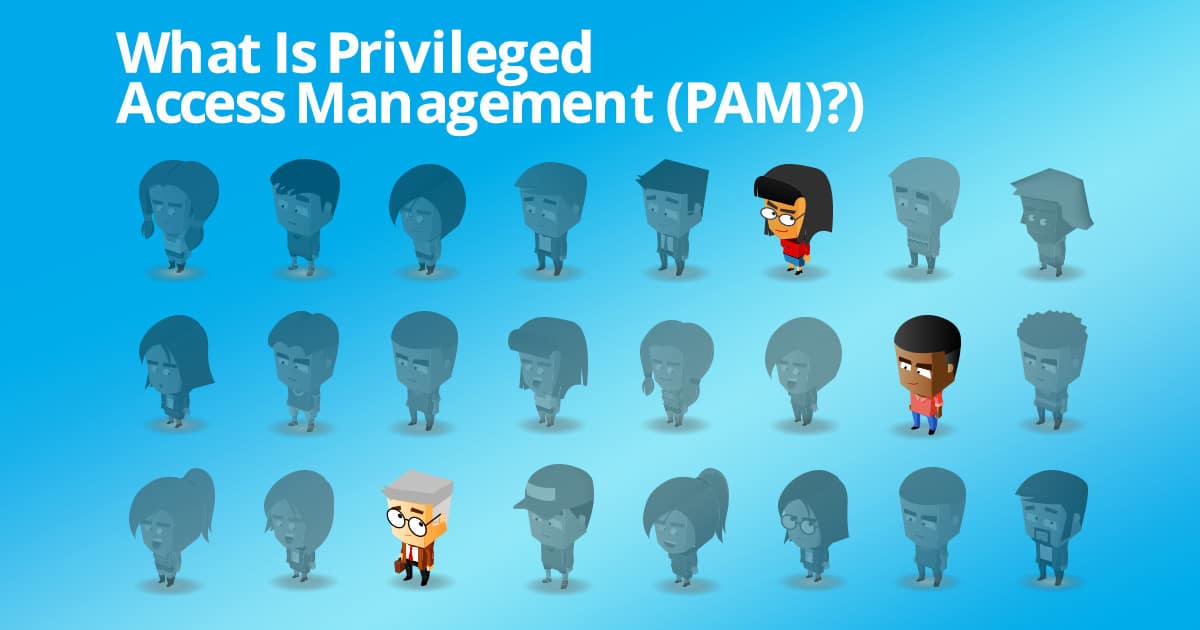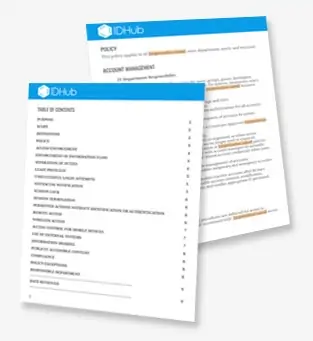
What Is Privileged Access Management (PAM)?
Privileged Access Management (PAM) consists of the comprehensive solution for cybersecurity and technology strategies, for controlling elevated (privileged) access, sessions, and permissions for users, accounts, processes, and systems, across an IT environment.
What is the difference between IAM and PAM?
While some overlap exists, Privileged Access Management focuses on specifics related to privileged accounts, or administrative access accounts. Identity Management, as a rule, includes managing access to any and all users, within a business system or network.
Privileged Access Management enables organizations to ensure users have only the necessary access levels needed to do their jobs.
What Is Privilege?
In an information technology context, privilege can be defined as the authority or level of security a given user, account, or process has within a computing system or network.
What is Privileged Access?
In an enterprise environment, Privileged Access is used to designate special access or abilities, above and beyond that of a standard user.
Privileged Access could be anything from an admin account on an application, or to fully control critical infrastructure, systems, and confidential data.
What is Privileged Administrative Access?
Privileged Administrative Access refers to full control and functionality, for a user across all workstations and servers within an organization's network.
What is a Privileged Account?
Any account that has been given elevated access and privileges beyond a non-privileged account would be considered a "Privileged Account".
What is Privileged Access Security?
Privileged Access Security (PAS), can also be referred to as Privileged Identity Management (PIM).
As discussed, the PAM designation is grounded in the principle of least privilege.
PAM relies on users only being granted the minimum levels of access required to perform their job functions.
What is Access Control?
The process of managing and controlling, granting or revoking, elevated access or administrator privileges, is considered access control.
Additionally, the abilities a user has across an organization, network, or even a single application or entitlement for an application, is part of access control.
Finally, the process is an ongoing one; once a user is initially authorized, permissions need to be granted or revoked over the user's lifetime, within the organization.
What are the benefits of Privileged Access?
PAM allows organizations to secure their infrastructure and applications, and run their operations efficiently.
Additionally, Privileged Access enables security teams to maintain the confidentiality of sensitive assets and data.
Finally, PAM allows teams to identify malicious activities linked to privilege abuse and take swift action to remediate risk.
What is Vendor Privileged Access Management (VPAM)?
This specialty subset of PAM is specific to Vendor Privileged Access Management. VPAM focuses on high-level external threats from an organization's reliance, on external service accounts or partners.
The process of supporting, maintaining, or troubleshooting certain technologies and systems utilized by vendors, falls into this category.
What are the benefits of VPAM?
VPAM provides a few areas of value to mitigate risks associated with third-party vendor access.
Typically, it is difficult to manage Vendor access to administrative accounts, due to the lack of oversight, and the potential number of users.
What is a Privileged Access Manager?
An Access Manager refers to the administrative user, or team of users, who manage, approve, revoke, and store permissions and privileged user information, across a network as new users are added, removed, or modified with different access levels.
With the addition of Cloud-Based PAM Systems, the necessity to hire teams and experts in Identity and Privileged Management is lessening. New systems allow for non-technical users to manage and write rules and pre-defined rules, used for controlling networks.
What are the challenges of managing Privileged User Access?
Organizations face several challenges protecting, controlling, and monitoring privileged credentials and accounts.
Managing account credentials is still a manually intensive, error-prone administrative process, which is used to rotate and update privileged credentials. Many IT organizations rely on single individuals or small groups, to continuously supervise all user's abilities within a network.
Effectively controlling privileged user access to cloud platforms can be extraordinarily difficult without a complete Identity Management Solution.
Software as a Service (SaaS) applications, external platforms, social media accounts, and other third-party platforms, create a complex system that is not easily managed by individuals without identity tools.
Additionally, creating compliant systems that manage risks and operational complexity, can be very difficult.
What are the risks of Privileged Access abuse?
There are many examples of the potential for massive failures and costs to businesses without proper Privileged Account Management.
Recent issues of severe breaches include The Office of Personnel Management to the Bangladesh Bank breach, and the Solar Winds breach, which incurred multiple attacks, including unsecured administrative passwords.
Examples of attacks that are predicated on the lack of identity security include the recent attack on the power grid inside of Ukraine, and the attacks on Oil and Meat organizations in the United States.
The re-occurring scenario in each attack, is always because of a breakdown at some point, regarding privileged credentials being exploited in order to plan, coordinate, and execute cyber-attacks.
What are the risks of Privileged Accounts?
"With great power comes with great responsibility." ~ Uncle Ben
Elevated capabilities and access, along with privileged user accounts, are a juicy target for hackers.
These accounts pose considerably more significant risks than non-privileged accounts and users.
The potential for misuse or abuse of privileged sessions by insiders or outside attackers presents organizations with a formidable security risk that re-enforces the necessity to effectively manage your Privileged User Accounts and all Administrative Accounts.
From internal privileged users abusing their level of access, or external cyber attackers targeting and stealing privileges from users to operate stealthily as "Privileged Insiders", humans are always the weakest link in the cybersecurity chain.
Organizations implement Privileged Identity Management (PAM) to protect against the threats posed by credential theft and privilege misuse.
What are the accounts available?
In a privileged environment, any (non-personal) account that is provided administrative access to the local-host or instance, is the only accounts which are considered to have elevated privileges.
What is a Non-Privileged Account?
Typically referred to as least privileged accounts, non-privileged accounts consist of either standard users with limited privileges, or guest accounts.
These types of accounts are typically limited to using the bare minimum abilities of software applications to perform their daily responsibilities.
Non-privileged accounts are usually defined by role-based access policies created by the organization.
Guest user accounts possess even fewer rights than standard user accounts.
What is a Superuser Account?
Superuser accounts are typically a specific type of account with elevated privileges, which are primarily used for specialized IT tasks or administration.
These types of accounts will frequently have full unrestrained power within a system. They are used to modify systems, execute commands, or enable other applications.
What are the risks of Superusers?
As always, the greatest risk to superuser accounts, are the humans who maintain that title.
These accounts have the potential to cause catastrophic damage to a system.
Such results could be due to simple user errors, such as inadvertently deleting critical information, or executing an unwanted command.
On the other hand, if misused maliciously, these highly privileged accounts can affect non-recoverable results for an entire enterprise.
Who can access the systems?
In some instances, unprivileged users with administrative access to secure systems in an emergency can be granted access to your systems based on your disaster recovery plan, or organizational security strategy and plan.
What is the best way to protect your network infrastructure?
LIFECYCLE PROTECTION
Control and secure infrastructure from end-to-end, throughout the lifecycle of all of your users. Developing a company-wide consistent strategy and protocols to be followed, will not only protect systems with proactive efforts but will also make it easy to spot instances where users have neglected to incorporate good policies.
MULTI-FACTOR AUTHENTICATION
Somewhat amazingly, the most basic protection strategies that provide significant protection, are the essential use of any multi-factor authentication.
Although, there are potential cracks in the ability of Multi-Factor to be 100% effective. The data generally shows that they are 99.9% effective, at about a 1 in 10,000 chance of being compromised, according to the latest statistics.
This single requirement, combined with a Managed Identity Service, can protect organizations from nearly every attack.
SESSION RECORDING
Implementing the ability and policy of recording susceptible accounts while they are in use, can identify issues and potential issues, as a much less intensive task.
BIO-METRIC IDENTIFICATION
The use of now-common technology, including fingerprint, iris, and facial recognition, can create a genuinely password-less organization when combined with single user sign-on access.
USE OF SECURE SOCKET SHELL (SSH)
Secure Socket Shell (SSH) key: SSH keys are heavily used access control protocols, which provide direct root access to critical systems.
A PLATFORM PASSWORD POLICY
With the move towards password-less environments, bio-metric scanning, and single sign-on, the idea of creating a set of password guidelines is quickly becoming outdated, and a security risk.
As always, humans again are consistently the weakest link in any security chain.
Any attempt at maintaining a password system or record of passwords is an immediate target for hackers.
What is the future of Privileged Access?
In digital business, privileges are everywhere and expanding. As more and more compliance requirements are being added by governments and organizations, the need for secure identities is no longer only for enterprise systems.
The recent explosion of Ransomware attacks on businesses' critical assets, has exposed the new trend of not only disabling corporations' internal confidential information, but hackers have also taken to blackmail by threatening the release of any compromising information.
This cost of simply exposing business financials and strategies can result in millions lost in revenue, in addition to the cost of not maintaining compliance regulations, even if the company has backups of the information and refuses to pay the ransom.
PAM allows businesses across a range of hybrid environments, to monitor suspicious activity and privileged activities, and create audit trails, which are used to prevent or mitigate potential losses.
As the technology to protect your sensitive assets continues to advance, so does the potential for malicious attacks. Maintaining a current security strategy is your best defense.
Learn more about PAM and Cloud Native
Listen to a group of cybersecurity experts discuss Privileged Access Management and Cloud Native Technologies in this panel discussion recording.
